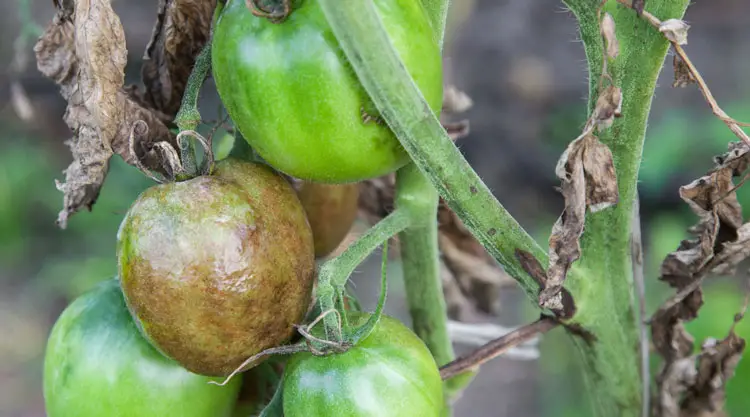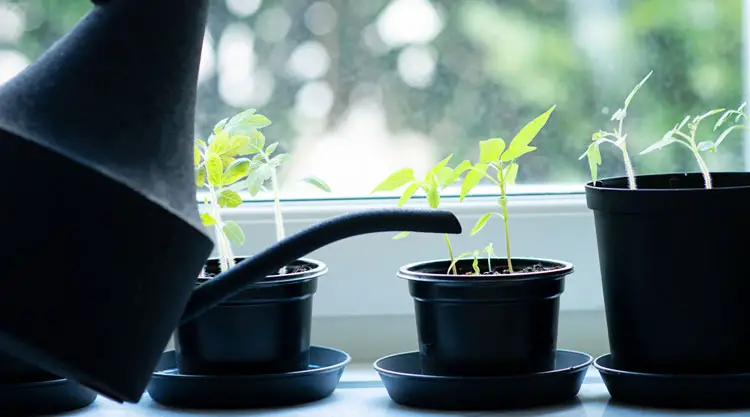How Long Does a Tomato Plant Live?

This post follows our research editorial guidelines.

Tomato plants are warm-weather crops cultivated extensively for their delicious and adaptable fruit around the world. The tomato is a flowering plant from the nightshade family, with over 10,000 known varieties. Although often labeled as a vegetable by nutritionists, tomatoes are actually a fruit, as they grow from a flower and have many seeds inside of it.
Tomatoes are commonly eaten raw, such as in salads, can be cooked, grilled, pickled or preserved, and are often processed into juices, purees, pastes, sauces, and condiments. They lend themselves well to canning, and can be found in cans whole, chopped, or pureed in grocery stores the world over.

Table of Contents
What is the lifespan of a tomato plant?
The average lifespan of a tomato plant is one growing season, or about 8-12 months, but when well-cared for in ideal conditions, tomato plants can live anywhere from two to five years. It can take anywhere from 60 to 100 days to harvest fruit from tomato plants.
In optimal conditions, a tomato plant can live for several years. However, most home gardeners treat their plants as annuals, replanting each year to ensure a fresh crop of tomatoes. With proper care, a tomato plant can provide an abundance of delicious fruits for many seasons. In fact, when posing this question to fellow gardeners many push their tomato plants to 6 or 7 years before they stop producing fruit.
There are some things that you can do to prolong the life of your tomato plant. If you live in a warmer area with a longer growing season, you can prune your tomato plant so that it doesn’t get too big and sprawling. You can also grow tomatoes indoors or in a greenhouse that will extend the growing season of your plants and protect them from harsh weather conditions.
Types of tomato plants
Determinant
A determinate tomato plant is a type of tomato plant that grows to a certain size and then stops growing. Determinant plants are often known as bush varieties, and typically grow two to three feet tall and produce fruit for about 4-6 weeks. The plant then dies once it is done fruiting. Most commercial tomatoes are determinate varieties, as they are easier to grow in large quantities.
Determinate tomato plants typically have a shorter lifespan than indeterminate varieties, but they can produce a larger quantity of fruit in a shorter amount of time; one determinant plant can produce up to 10 pounds of tomatoes. Determinate tomato plants are better suited to cooler climates, as they can tolerate shorter growing seasons.
Lifecycle

A determinate tomato plant’s life cycle can be divided into four stages: germination, growth, flowering, and fruiting. Germination is the process by which a seedling first starts to grow.
Once the seedling has broken through the soil, it begins to put out leaves and roots and starts to grow taller. Once the plant has reached its full height, it begins to produce flowers.
Once the flowers have been pollinated, they start to form fruits.
Once it blooms and sets fruit, the plant will continue to produce tomatoes until it is killed by frost or disease. Depending on the variety of tomato plant, the whole lifecycle can take anywhere from 50 days to several months.
Indeterminant
Indeterminate tomato plants continue to grow and produce fruit throughout their lives. These plants are usually vine-like in appearance, and can get very large, sometimes reaching six feet tall or more. Because they keep growing and producing fruit indefinitely, indeterminate tomatoes require more care than determinate varieties. While determinate tomato plants produce all of their fruit at once, indeterminate tomato plants produce fruit continuously throughout the growing season. As a result, indeterminate tomato plants are often preferred by gardeners who want a continuous supply of fresh tomatoes.
Lifecycle
The lifecycle of an indeterminate tomato plant begins in the spring, when the plant is started from seed. The plant will then continue to grow and produce fruit until the fall, when it will be killed by frost. In some cases, indeterminate tomato plants may produce fruit for two years or more before they need to be replanted. Indeterminate tomato plants are typically varieties that are grown in warm climates, as they require a long growing season in order to produce an abundance of fruit. While indeterminate tomato plants require more attention than determinate varieties, they often yield a larger harvest.

How do you keep tomato plants alive?
To keep your tomato plants alive and healthy, plant them in a spot with at least 6 to eight hours of sunlight, water them regularly, and fertilize them every two weeks or so. Extreme heat or cold can damage tomato plants, so it’s important to take steps to protect them from the elements. If you live in a particularly cold climate, you may want to consider growing your tomatoes indoors or in a greenhouse.
Watering
Water tomato plants deeply and regularly. Tomato plants need about an inch of water per week, and it is best to water them in the morning so that the leaves have time to dry before nightfall. Water your tomatoes regularly, but be careful not to overdo it – too much water can actually drown the roots and kill the plant. Allow the top inch or so of soil to dry out between watering
Light
Tomato plants need plenty of direct sunlight, and will produce more fruit if they are grown in a sunny spot. Tomatoes need at least six to eight hours of sunlight per day, so planting your tomatoes in a south-facing location, whether inside or outdoor, is ideal.
Fertilizer
Fertilizing your plants regularly is important to produce a steady crop of fruit. Tomatoes are heavy feeders and will benefit from being fed high-quality fertilizer every few weeks. Almanac.com also recommends to “avoid fast-release fertilizers and avoid high-nitrogen fertilizers… too much nitrogen will result in lush foliage but few flowers and little or no fruit.”
Pruning and staking
Prune your plants regularly to encourage new growth. Remove any dead or diseased leaves or branches promptly, and don’t be afraid to cut back on healthy growth if the plant is getting too big. Small suckers (the new, tiny stems and leaves that will begin to grow between branches and the main stem) can be pinched off regularly before they get too big. This allows more energy to be directed to the fruit-producing parts of the plant, and less to new stem growth.
Finally, give your tomato some support – whether it’s a cage, trellis, or a stake – to keep it from toppling over as it grows. Gently secure branches to your chosen support with soft twine, old rags or nylons so as to not damage the delicate branches.
Weather conditions (Zones)
For best results, tomatoes should be grown in weather zones that offer warm days and cool nights. This combination of weather conditions helps the tomatoes to develop their characteristic sweetness. In general, tomatoes do not do well in areas with extremely hot or cold weather. However, they can also be sensitive to excessively hot weather, so it is important to choose a location that does not get too hot during the summer months.
While they can be grown in a variety of weather conditions, tomatoes tend to thrive in warm, sunny weather. For this reason, the best weather zones for growing tomatoes are typically found in the southern and western parts of the United States. However, tomatoes can also be successfully grown in other parts of the world if the weather conditions are right. For example, tomatoes will grow well in areas with long, hot summers and short, cool winters. If you live in an area with cooler weather, you can still grow tomatoes by using greenhouse cultivation methods.

Growing Tomatoes in a Greenhouse
Growing tomatoes in a greenhouse can be a great way to extend the growing season and enjoy fresh tomatoes year-round. Greenhouses provide protection from harsh weather conditions, pests, and diseases, allowing plants to thrive. They also create a controlled environment, which means that temperature and humidity levels can be regulated to provide ideal conditions for tomato plants. Tomato plants need at least six hours of sunlight each day, so it is important to choose a location for the greenhouse that receives plenty of sun. Greenhouses can extend the growing season by trapping heat inside, allowing tomatoes to ripen earlier than they would if they were grown outdoors. A greenhouse should also have good ventilation to prevent dampness and mold growth. When it comes to watering, tomatoes prefer a consistent supply of moisture. However, be careful not to overwater in a greenhouse, as this can lead to problems such as blossom end rot. Once the plants begin to produce fruit, greenhouse tomatoes will also need support in order to prevent the fruits from touching the ground and rotting. Staking or trellising are both effective methods for providing support in a greenhouse setting.
Of course, there are also some challenges associated with greenhouse gardening. For example, it can be difficult to control the amount of light that plants receive. Additionally, greenhouses can get very hot during the summer months, which can stress tomato plants and cause fruit to blister. One of the keys to success when growing tomatoes in a greenhouse is providing adequate ventilation. Tomato plants produce a lot of heat as they grow, and this can quickly build up in a closed space. By opening vents or doors during the hottest part of the day, you can help to keep the temperature inside the greenhouse from getting too high. In addition, it is important to choose varieties of tomatoes that are well-suited to greenhouse conditions. Some varieties are more heat-tolerant than others, and these will be more likely to produce good fruit in a warm environment.

Growing tomatoes indoors
Growing tomatoes indoors can be a great way to get fresh tomatoes year-round. Tomatoes are a relatively easy crop to grow, and with a little attention they can produce an abundance of fruit inside. There are a few things to keep in mind when growing tomatoes indoors. First, make sure to choose a variety of tomato that is suited for indoor growing. Smaller varieties like cherries or grape tomatoes are usually best suited to indoor growing. Second, provide your plants with plenty of light – tomatoes need at least six to eight hours of direct sunlight per day, ideally in a southern-facing window. If you live in an area with limited sunshine, consider using grow lights to supplement the natural light. Third, water regularly and fertilize monthly to ensure your plants are getting the nutrients they need.
Final Thoughts
Overall, tomato plants are an easy-to-grow, low maintenance crop that naturally has a shorter growing season, although with a little care and attention can be cultivated to produce luscious fruit for many years. While most tomato plants live for one growing season, there are multiple ways to extend the lifespan of your tomato plants to ensure you have a steady supply of delicious tomatoes for years to come.
